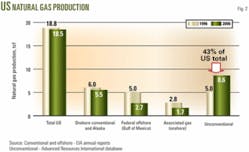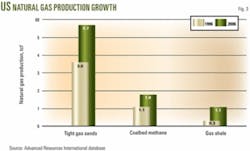From an emerging resource 1 decade ago, and a mostly overlooked resource 2 decades ago, unconventional gas is now a core business of many large independent producers and a growing number of the major oil and gas companies. This resource has become a mainstay of the US natural gas industry (Fig. 1).
The catch phrase “the future is unconventional” appropriately captures the trend for this important domestic hydrocarbon resource.
Unconventional gas includes tight gas sands, coalbed methane, and gas shales.
This first of six articles will describe the growth of the resource during the past decade. The remaining articles in the series will cover:
- How much tight gas, coalbed methane, and gas shale resources remain undiscovered and undeveloped.
- Emerging unconventional gas basins and plays.
- Importance of technology progress for unconventional gas.
- Economics for unconventional gas.
- Outlook for unconventional gas.
These articles will show that the US is not running out of domestic unconventional gas resources. Rather, the nature of the remaining undeveloped unconventional gas resource base is shifting towards more challenging reservoir settings. Continuing and even accelerating progress in technology will be essential to develop this remaining resource base efficiently and economically.
The recent formation of the gas technology institute called RPSEA (Research Partnership for Securing Energy for America) prompts optimism that investments in unconventional gas research and development (R&D) will rebound and technology progress will, once again, keep ahead of resource depletion.
Resource highlights
During the decade 1996-2006, unconventional gas achieved notable successes.
Production of unconventional gas reached a new peak of 24 bcfd (8.6 tcf/year) in 2006, up from 14 bcfd (5 tcf/year) 1 decade ago. With a 43% share, it is now the dominant source of domestic natural gas production (Fig. 2).
Annual production for all three unconventional gas sources increased during the past decade (Fig. 3). Tight gas provided the largest production growth, nearly 6 bcfd (2.1 tcf/year). Gas shales had the largest percentage growth, up by more than threefold. Coalbed methane production also increased, to nearly 5 bcfd from 3 bcfd.
Driven by record drilling, proved reserves of unconventional gas also have increased to a new record of 105 tcf at the beginning of 2006, up from 48 tcf in 1996. Today, unconventional gas accounts for more than half of the reported 196 tcf of proved natural gas reserves in the Lower 48 states.1 Large volumes of probable and possible reserves, as well as a large undiscovered resource base, underlie these proved reserves.
After accounting for production replacement, total unconventional gas reserves additions were an impressive 120 tcf in the past 10 years.
More intense development of emerging gas plays as well as the discovery of several new plays has driven the growth in unconventional gas. For example, with aggressive infill and extension drilling, the Mesaverde formation of the Piceance basin has become a major 1 bcfd tight gas-sand play, up from a modest 0.1 bcfd prospect 1 decade ago.
With expansion of Cotton Valley development, addition of the deep Bossier, and revitalization of the Travis Peak play, the tight gas sands of East Texas now provide 3.6 bcfd, up from 1.5 bcfd 10 years ago.
Finally, no review of unconventional gas can overlook development of the Barnett shale in the Fort Worth basin, producing almost 2 bcfd today, up from less than 0.1 bcfd in 1996.
Gas shales also have been a source of several new unconventional gas plays, particularly the Fayetteville and the Woodford gas shale of the Arkoma basin. Other new and emerging unconventional gas plays include the low-rank coalbed methane play in the Powder River basin and the deep Wasatch-Mesaverde tight gas sands in the Uinta basin.
Motivated by past advances in technology and expectations of continuing high natural gas prices, many producers have entered the unconventional gas arena, driving well drilling and completion to steadily higher levels. From a base of about 5,000 new wells/year from 1996 to 2000, producers have added more than 20,000 new unconventional gas wells in each of the past 2 years (Fig. 4).
Drilling of tight gas sands, at 13,000 wells/year, still dominates the activity with coalbed methane and gas shale each providing 4,000 wells/year. Overall, the industry has drilled 102,000 new productive unconventional gas wells during the past decade, accounting for about two-thirds of all successful natural gas wells drilled.
With production up by 10 bcfd, with 102,000 successful wells drilled and completed, and with 120 tcf of reserves added, unconventional gas has clearly made progress during the last decade.
Potential problems
Even with the growth in importance of these resources, dark clouds have begun to appear on the horizon for unconventional gas. For many years, progress in technology countered resource depletion, holding the key performance measure, reserves added/well, relatively constant. This, unfortunately, is no longer the case.
With reductions in unconventional gas R&D and technology investment (including termination of the Gas Research Institute and decline in the US Department of Energy (DOE) gas research and technology program), overall technology progress has slowed considerably.
As a result, since 1996-2000, reserves/well for all three unconventional gas resources have declined sharply (Table 1).
For tight gas sands, well productivity declined by more than half, to 1 bcf of proved reserves/new successful wells drilled in 2003-05 from the 2.2 bcf/well in 1996-2000. With the rapid change to lower productivity (but also lower cost) Powder River and Mid-Continent coalbed methane plays, reserves/well for this resource have declined even more, to 0.5 bcf/well in the past 3 years from 1.6 bcf/well in 1996-2000.
One partial silver lining is the recent reversal in gas-shale well productivity decline. The increasing use of new technology, such as multiple-stimulated horizontal wells particularly in the Barnett shale, is one reason for this improvement.
Higher natural gas prices and the persistent pursuit of efficiency by operators have enabled lower productivity unconventional gas plays, with lower reserves/well, such as the Clinton-Medina tight gas sands in the Appalachian basin, the Canyon tight gas sands in West Texas, and Wyodak coalbed methane in the Powder River basin, to be more aggressively developed, contributing to the overall decline in reserves/well.
The decline in well productivity, however, appears to be a more fundamental problem. For example, of the 43 tight gas plays that Advanced Resources International Inc. tracks in its model of unconventional gas supply (MUGS) database and model, 20 of these plays had severe declines in reserves/well during the past 3 years.
On the “good” side of the ledger, unconventional gas has achieved a number of impressive successes in the past decade. First, there are the new, large (bcfd) size plays such as the Barnett shale, the Pinedale-Jonah tight gas sands, and Powder River coalbed methane. Ten years ago many in the industry questioned whether any bcfd-size natural gas plays were even left in the Lower 48.
Second, the unconventional gas development experience provides solid evidence that increased drilling can and will lead to increased gas production and reserves, counter to the “sound-bite” message by some energy analysts that higher levels of drilling are having no effect. For example, with increased well drilling, unconventional gas has more than replaced the steep, 5.4 bcfd (2 tcf/year) decline in Gulf of Mexico gas production since 2000 (Table 2).
On the “bad” side of the unconventional gas ledger is the decline in technology progress. All key measures of the rate of technology progress that ARI tracks in MUGS are down.
These technology progress measures (levers) include among others:
- Efficiency and volume of reserves added from well recompletions, restimulations, and identification of bypassed pay.
- Ability to reliably identify and delineate the higher productivity, sweet-spot portions of an unconventional gas play.
- Rate of improvements in well drilling and completion efficiency.
- Track record of success in overcoming environmental and other constraints impeding access to undeveloped resources.
Finally, the “ugly” is the sharp rise in costs and economic risk. Because of the reserves decline/well and the upward spiral in well drilling and completion costs, much of the unconventional gas resource has become a high-cost resource play. Even though oil prices (a reasonable proxy for natural gas prices, except in the past year) have increased by 23%/year since 2002, finding costs for US exploration and production companies have increased even faster, by 38%/year during this time.2
Should natural gas prices decline and remain at $4-5/Mcf (Henry Hub spot price), as seen in the early years of this decade, many of the unconventional gas plays would become uneconomic. Of course, with a drop in gas prices, well drilling and completion costs may also decrease, and the associated loss in gas production might then provide a price rebound, unless low-cost LNG imports fill the gap.
References
- “U.S. Crude Oil, Natural Gas, and Natural Gas Liquids Reserves 2005 Annual Report,” DOE/EIA-0216(2005), US DOE Energy Information Administration, November 2006
- Southwestern Energy Co., June 2007 update, using data from Bloomberg and John S. Herold Inc.
The author
Vello A. Kuuskraa ([email protected]) is president of Advanced Resources International Inc., Arlington, Va. He has more than 30 years of experience in the oil and gas industry, particularly in unconventional oil and gas resources, enhanced oil recovery, and CO2 sequestration. Kuuskraa holds a BS in applied mathematics from North Carolina State University and an MBA from the Wharton Graduate School, University of Pennsylvania. He serves on the Board of Directors of Southwestern Energy Co.








